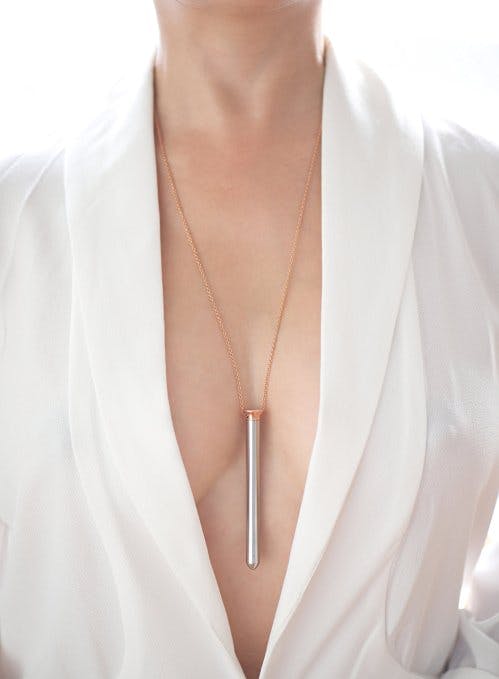Do sex toys need liberation? Maybe once upon a time. But in the 21st century, I doubt many people are fainting at the sight of, like, a phallic eggplant. Vibrators, dildos, cock rings, and every other category of carnal paraphernalia are a part of modern life, whether people talk about it or not. Even our president has starred in softcore porn.
That being said, however, the Crave’s “Vesper” vibrator might make even the most sex-positive libertine blush. It’s a beautiful object, with three custom shades of silver, copper, and gold, serving as a tasteful counterpoint to the chunky Fisher Price plastic of your standard Spencer’s Gifts fare.
But the Vesper also comes with a delicate chain that let’s you mount your vibrator like a necklace. The aesthetics are subtle enough that it’s easy to pass off the Vesper as any other piece of jewelry—and that’s the point. Designer Ti Chang believes that if we’re expecting women to spend a not-insignificant amount of money on a sex toy, they should be at least able to take it out of the house.
“There are very few women in industrial design, and women are underserved in the design of everyday objects,” says Cheng. “When you have predominantly male teams designing products and experiences for the mass market, you often have products marketed toward women but not actually designed for them. The world of sex toys is the perfect example of this disconnect.”
She says the Vesper “is about openly embracing pleasure as a statement without compromise to its design as a jewelry piece and as a vibrator… I guess you can say I want it all.”
To be clear, this isn’t the only discreet vibrator on the market. There are more gimmicky products that try to hide their true functionality in, say, a fake cupcake, or a tube of lipstick. These are cheap, silly, and ripe for bachelorette debauchery, but Chang thinks they send the wrong message.
“[Those products say] that we should be apologetic and hide our pleasure,” she says. “To me, this is an even worse version of ‘shrink it and pink it,’ the belittling approach to designing products for women by creating cutesy novelties. Why do our orgasms need to be cute?”
There is something powerful about elevating a sex toy into something cherished and valued, since the boorish, masculine designs of your average vibrator mostly induce giggles about sexuality and avoid more serious conversations about self-care. Frankly, I think it’s charming to find sex toys in a friend’s bathroom—it’s like a quiet contract between acquaintances that, yes, we’re not going to spend hours before we company comes over scrubbing our home of any artifacts of our sexuality, and that yes, it isn’t a big deal.
“I can embrace my sexuality proudly and publicly, but without inspiring criticism from those who believe women shouldn’t be sexual creatures.”
But while there are lots of aesthetic and political statements to make with the Vesper, let’s be honest: Most of the appeal is the thrill of doing something naughty in public.
“It does turn me on to wear it because it’s like an exciting secret,” says Penny, a proud owner of a Vesper. “I can embrace my sexuality proudly and publicly, but without inspiring criticism or disdain from those who seem to believe women shouldn’t be sexual creatures. I guess you could say it’s a bit like me—seemingly innocent-looking but with a deeply sexual side. I love that duality.”
If you fork over the additional money, you can choose to have your Vesper engraved with a few choice words, further cementing it as something beyond a simple sex toy. Penny chose “temperance, like chastity, is its own punishment,” which is about as playful as it is true.
There’s no reason to disparage the sillier, funnier variants in sex toy design, either. Intimacy is supposed to be fun, and that can manifest through triple-figure designer vibrators and a pink pair of handcuffs. But there needs to be range. People deserve the option to invest as much into their orgasm as they choose.
The Vesper merges aesthetics, politics, and kink into a single package, but at the end of the day, it’s positioned as a consumer showpiece. Frankly, there’s nothing more liberating, or at least American, than that.



